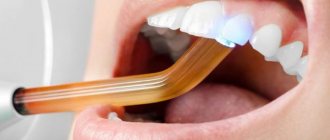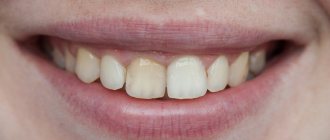Toothache is considered one of the most severe and unpleasant pains. If a problem arises and does not go away in the near future, you need to go to the dentist and solve it. What to do if the tooth doesn’t hurt so much as it reacts to the cold? Quite often, pain occurs when eating hot food, and then after a certain period of cold food. Such behavior of the teeth indicates that there is an infection in the body and it requires root canal treatment.
Periodic toothache, which makes itself felt when a person takes a sip of cold water or another drink, usually indicates increased sensitivity of the enamel of the neck of the teeth. This feeling cannot be called a disease. Most likely it is a dental condition. There are many reasons for this: the individual characteristics of the body, pathologies of hard tissues, demineralization of enamel. The enamel cannot fully perform all its protective functions, and therefore such damage occurs.
Acute pain is usually caused by pulpitis. The pulp is the soft part of the tooth, which tends to become inflamed under the influence of bacteria that enter it from a cavity affected by caries. The causative agent of this disease is streptococcus. Quite often, pulpitis occurs due to injury to the tooth or due to exposure to chemicals: acids, alkalis. The causes of problems with hard dental tissues are often caries, abrasion, and hyperesthesia. In such a case, the pain goes away immediately after the irritating factor is eliminated.
Causes of acute reactions to temperature stimuli
Increased sensitivity of enamel in medicine is referred to as “hyperesthesia”. The condition is manifested by acute toothaches with a sharp change in temperature. In this case, discomfort is usually observed in any one area of the jaw. There are several causes of the pathological condition, each of which should be considered separately.
Caries or pulpitis
A carious lesion is a black or brown dot on the enamel. Damaged teeth become susceptible to any external influences, including temperature. Painful sensations also occur in the initial stages of pathology, when caries is at the chalk spot stage. The symptom signals the beginning of enamel destruction, which without timely intervention will be complicated by damage to dentin and pulp.
Poor quality dental treatment
After visiting a doctor, there is a risk of increased enamel reaction to cold food. The problem is associated with poor cleaning of the dentinal tubules and incomplete removal of nerve endings. Another doctor’s mistake that leads to pathology is loose filling material. The temperature provocateur enters the deep layers of the tooth, thereby causing negative reactions. The situation requires a second visit to the doctor. Otherwise, the filling will be destroyed and discomfort when eating food will increase.
Whitening
To improve the appearance of their teeth, many patients resort to whitening procedures. It gradually leads to a thinning of the enamel surface and a decrease in its density. The problem is not a reason to panic; it is enough to follow some rules for several days after whitening: remove sour and sweet foods and ice water from your diet; include fish, cottage cheese and other dairy products that contain calcium and phosphorus in the menu. These elements play a vital role in the formation of tooth enamel.
The teeth whitening procedure may cause the element to react to cold
Why does a tooth react to cold? Other external factors that lead to the development of the problem should be noted:
- Consumption of products with aggressive chemical composition – carbonated drinks; foods with citric acid. The substances gradually dissolve the bone tissue of the tooth and thin the enamel.
- Mechanical damage to elements. Injury occurs from accidental blows or from consumption of hard foods (chips, crackers, nuts).
- Malocclusions that cause uneven load on the units. Improper closure of teeth causes enamel wear.
- Exposing the neck of the element. The tooth hurts from cold due to increased dentinal sensitivity. In the problem area, there is detachment of the gums or its receding.
- The period after treatment. In normal conditions, increased sensitivity of the enamel lasts no more than 1 week.
- Bruxism, or involuntary teeth grinding.
How to properly help yourself?
Content:
- How to properly help yourself?
- How to avoid the problem?
Everyone understands that if you experience any pain or other unpleasant and suspicious symptoms in your teeth, you should immediately consult a doctor. There are situations in which a person cannot do this immediately. Therefore, you have to help yourself before contacting a specialist. You can reduce toothache with a salt solution. You need to rinse your mouth as often as possible using warm water. The main thing is not to swallow the salty solution. Clove oil, which can be purchased at any pharmacy, can also help. There is information that it contains 80 percent eugenol, an anesthetic. The product is affordable and works quickly. It is also quite simple to use; just add a drop of oil to a cotton swab and apply it to the tooth. If the oil gets on the pain receptor itself, it will act even more effectively.
If a person’s filling has fallen out, then clove oil will be very helpful. They should moisten the swab and close the resulting cavity before visiting a doctor. In this way, you can protect your tooth from food particles, cold air and other irritating factors.
Soreness from cold can occur due to damage to the enamel. A tooth is not protected from the cold if it has chips, cracks and other defects. It is the absence of enamel that causes maximum discomfort in the oral cavity when a person drinks cold food or simply talks in frosty weather. This problem can be solved if you start using a special toothpaste. It is important to pay attention to the duration of the pain. Most often, the pain subsides after a few seconds as soon as the tooth warms up. If the pain does not stop for a long time, then it is caused by pulpitis. In this case, you should not postpone your visit to the doctor.
Another cause of tooth sensitivity can be dentinal sensitivity. It is possible if the dental bone is open. Typically, enamel covers this bone behind the gum line. The dentin itself consists of small holes called tubules. Each of the tubes contains a nerve that comes out of the main part of the tooth - the pulp. People especially experience pain if the dentin is exposed and exposed to cold temperatures.
Internal factors causing the problem
For the first time, people discover hyperesthesia while brushing their teeth. After the procedure, the discomfort disappears. Thus, the nerve endings signal that problems with the enamel have begun.
A sudden acute reaction to temperature changes may not be associated with dental problems or injury. Among the internal causes of hyperesthesia, it should be noted:
- Gastritis. The hallmark of the disease is heartburn. Acid coming from the stomach into the esophagus negatively affects the condition of the teeth and thins the enamel. As a result, the elements react sharply to cold and hot.
- Endocrine pathologies (diabetes mellitus, etc.). Problems lead to insufficient supply of micronutrients to the jaw structures. As a result, there is a death of bone tissue and an increase in their sensitivity.
- Age characteristics.
- The special composition of saliva.
In healthy people, saliva contains calcium, which blocks the dentinal tubules. In some cases, this component is missing, which increases the reaction to cold
Causes of tooth pain when consuming hot foods
If the tooth reacts to heat, this indicates exposure of the nerve endings. A symptom that appears for a long time indicates a pinched nerve in the tooth. It will not be possible to cope with the problem without the help of a dentist. In such cases, the dentist performs depulpation of the problem segment
Can an element without a nerve react acutely to temperature changes? The answer to this question can be positive, since many people after surgery report pain in the area for several days. Discomfort is noted when pressing on the crown and when drinking cold water. If the unit hurts constantly, then this is a sign of improperly performed dental treatment: the doctor could have poorly cleaned the dental canals; leave a foreign object in the treated cavity. In this case, you need to urgently contact another specialist as quickly as possible.
Stages of the problem
Over time, tooth sensitivity increases due to thinning of the enamel. It is this layer that protects teeth from external irritants: sour, sweet, bitter foods. As long as the enamel is thick, there is no discomfort during eating. When this layer thins, an acute reaction of the elements to possible types of food is noted, especially sweet, sour, cold and hot. Temperature irritants quickly penetrate dentin and affect nerve endings, causing acute pain.
Pathology goes through several stages in its development:
- The tooth feels cold and hot.
- Enamel reacts to salty, sour and sweet foods. Gradually the list of irritants expands.
- Elements react to any external stimuli, not just temperature ones. Inhaling air can cause severe pain. In advanced cases, unpleasant symptoms constantly plague a person, regardless of whether he eats or not. The situation leads to a decrease in the quality of life.
Under the top layer there is dentin, behind which sensitive nerve endings are hidden.
Diagnostics
If a tooth hurts from hot or cold, then this is the first sign of improper sealing of the canals. You can check the quality of your dentist's work by drinking a glass of cold water. With unfinished caries, unpleasant sensations will arise immediately, with pulpitis - after a certain period of time. If such symptoms are detected (3-4 days after treatment), you should contact your dentist again, as the discomfort will not disappear on its own. Caries and pulpitis in the complication stage lead to the loss of a unit or infection of the bone structures of the jaw.
The dentist must assess the general condition of the patient, examine the tissues of the oral cavity, determine the degree of sensitivity of the enamel to external irritants and prescribe an x-ray to the patient. If the patient reacts sharply to cold or heat, then the doctor completely removes the previously installed filling. After re-cleaning the canals, the specialist installs a new filling material.
Tooth hurts after filling
Author of the article: Kondratyeva Tatyana Yuryevna Dentist therapist of the Highest category
This is a very common question on the Internet. Indeed, if a tooth hurts before visiting the dentist, this is understandable, but when the tooth is cured and still hurts...???! Today I will talk about the most common causes of such pain.
If you apply for complicated caries (pulpitis or periodontitis), then treatment ends with filling the canals. We have already talked about the complex anatomy of the canals, so it is difficult to process them, wash them, and get to the smallest branches where microbes can “sit.” And the procedure for removing the nerve itself is associated with trauma, because the doctor has to “cut off” the neurovascular bundle at the apex of the root. As a result, swelling and aseptic inflammation form in the tissues surrounding the root, which the patient feels as pain when biting. If the swelling in the periodontal fissure is significant, then the patient has the feeling of an “overgrown tooth.”
If a living nerve is preserved in one of the branches of the canals, then pain occurs from hot food (although sometimes the inflamed gums also hurt from hot food). Well, if the inflammation that began inside the tooth, despite its treatment, still continues, and this depends on the body’s resistance and on the load on the tooth (let’s assume the patient has significant loss of teeth and needs prosthetics), then a situation arises when an abscess (ulcer) forms, which is opened surgically, and the inflammation is extinguished with the help of antibiotics.
In any case, the less of these sensations the better the quality of canal treatment and filling.
The tooth may hurt even after treatment of uncomplicated caries. So, after treatment of deep caries, sometimes nighttime, spontaneous and long-lasting pain occurs from cold, and then from hot. With such complaints we are already talking about pulpitis. The fact is that the diagnosis of deep caries and the chronic form of pulpitis, when there are no complaints, is practically indistinguishable. After all, what caries is is destroyed tooth tissue stuffed with microbes. And if the cavity is deep, then the infection comes close to the nerve.
All dental therapists are great optimists and are always determined to keep the tooth alive and more functional. Indeed, the idea of removing, say, a finger if it starts to hurt doesn’t occur to anyone??!! Such deep cavities are treated with the application of therapeutic pads, observing the rules of asepsis and antisepsis, and the patient is warned about the possible removal of the nerve subsequently.
After caries treatment, pain sometimes occurs when biting at a certain point.
It happens :
A) if the filling is too high and under anesthesia the patient cannot perform the entire range of movements of the lower jaw, which enable the doctor to grind the filling so that it does not interfere.
B) if post-polymerization stress phenomena occur. The fact is that modern filling materials, light-curing composites, have one negative property (with many positive ones!!!) this is polymerization shrinkage.
In other words, during the curing of the composite, the filling decreases in volume, and since the adhesive bond glues the filling so strongly to the walls of the tooth, they (the walls) begin to experience stress. Moreover, this force is so great that the enamel cracks and first a microscopic gap is formed around the filling, and then quite a significant one. Some patients may have noticed that a matte white stripe first forms around the filling, and then a brown one; this happens when food pigments stain the imperfections around the filling.
One of the reasons for tooth pain after filling is enamel stress
Sometimes these pains are associated with the formation of this microscopic gap under the filling, at the bottom of the carious cavity, or the formation of a pore, a tiny air bubble, in the thickness of the filling, which can form during plastic processing of the composite. In this case, chewing pressure is inadequately transmitted to the pulp and pain occurs. The same symptoms appear if the adhesive, for one reason or another, fails to saturate the tooth tissue well and sensitive areas remain unsealed, causing patients pain when exerting themselves.
C) sometimes after treatment there is sensitivity from cold and discomfort when touching, say with a toothbrush, certain areas of the enamel. Then we talk about superficial sensitivity or hyperesthesia.
Treatment of a tooth involves its preparation with burs, numerous washings, treatment with acids, drying, polishing with abrasive pastes, heating, pleasure, the list of all effects on the tooth is not yet complete. Therefore, sometimes sensitive people with sensitive teeth experience such symptoms. After reading this article, do you get the impression that dental treatment is harmful? I want to reassure you and inspire optimism: for a high quality of life and general health, you need to have beautiful, healthy teeth, which means you need to care for them, treat them, and clean them! And competent specialists, professional dentists who have good equipment, modern technologies and materials, the desire and ability to help you, our dear patients, will help you with this.
Do you have any questions? Get an answer right now using the “Ask a question” form. We will be happy to help you.
»
Oral care products
What to do if your teeth hurt from the cold? First of all, you should change your oral care products. The pharmacy sells special toothpastes for teeth with increased sensitivity. The list of such funds includes:
Biorepair toothpaste
- Sensodyne. Contains zinc and sodium fluoride. Due to these components, the enamel is strengthened and its sensitivity to external influences is reduced. In addition, toothpaste destroys pathogenic microorganisms on the enamel surface and reduces the amount of plaque.
- Lakalut. Contains active phosphorus, which has a beneficial effect on the condition of the upper layer of the tooth. The effect of using toothpaste is observed after a certain time.
- Silca. In addition to active fluorine, it contains potassium citrate and urea. These substances reduce the sensitivity of enamel.
What can I do to stop my tooth from overreacting to food? Emergency assistance is provided by special gels:
- ROCS Composition is applied to enamel that is sensitive to cold and hot foods and drinks. The gel contains phosphorus, magnesium and calcium. The gel creates a film on the surface of the enamel, which protects it from external negative influences. At the same time, the surface of the element is intensively supplied with useful microelements. After treatment, the tooth lightened by several shades.
- Emofluor. The tin fluoride in the gel destroys bacteria that cause caries. The product is used to reduce tooth sensitivity and prevent periodontitis.
- Fluoridex. The product acts as a prevention of caries and other dental diseases. The gel is used together with toothpaste, adding a small amount of the substance to the brush. The procedure for treating enamel with gel is carried out twice a day - morning and evening.
Fluoridex contains a small amount of sodium fluoride, so it can be used to prevent caries in children and pregnant women
Prevention
Teeth hurt from temperature changes (cold and hot), but this does not mean that in order to prevent the problem, any external influence should be limited as much as possible. The modern market offers many pastes, gels, ready-made rinses and other compositions that can prevent the appearance of an unpleasant symptom or suppress it at the earliest stages. Since the composition of all products is different, doctors advise changing them periodically. In this case, it is better to exclude special bleaching agents altogether.
There are also general rules, if followed, you can protect yourself from the occurrence of hypersensitivity:
- High-quality oral hygiene. Cleaning is carried out at least 2 times a day, morning and evening. After eating, you should rinse your mouth and use floss.
- Nutrition is adjusted, it must be balanced. It is important that the foods you eat contain sufficient amounts of minerals, vitamins and other valuable components. It is recommended to limit the consumption of sweets, hard nuts and seeds, and soda as much as possible.
- Consult your doctor about possible intake of vitamin-mineral complexes.
- You should visit the dentist 2 times a year. Even if nothing bothers a person, the doctor is able to diagnose the disease at its very beginning.
What should you do if your tooth feels cold and hot, or is swollen by the breath of a chilly autumn wind or a sip of freshly prepared tea? The first thing you should do is contact a dental clinic. Only a physician will be able to carefully examine the oral cavity and identify hidden pathological processes that lead to the occurrence of increased sensitivity. Specialists will help you understand the causes of the disease and develop effective therapeutic tactics. Call or leave requests on our website.
Principles of treatment
If the sealed unit reacts sharply to external factors within 3 days, then this condition is considered normal. The symptom goes away on its own a few days after the procedure. To alleviate the symptoms of the problem, you can take drugs with an anesthetic effect.
If tooth pain when eating food is associated with other factors, then the solution to the problem will be carried out comprehensively. When drawing up a treatment regimen, the etiology and symptoms of hyperesthesia are taken into account.
First, the doctor carries out sanitation of the oral cavity: professional cleaning of the enamel; removal of carious lesions; removal of old fillings. After this, the patient is prescribed vitamin complexes to support the immune system. With complex treatment, toothache from consuming cold and hot foods goes away in 99% of cases. Only in rare situations (1% of cases) is it impossible to eliminate the problem, since it is associated with the anatomical features of the enamel structure.
The easiest way to relieve toothache is to avoid eating cold and hot foods. If the symptom is additionally associated with inflammatory processes in the oral cavity, then you can put an analgesic tablet on the problem area or take the drug orally.
Painkillers are taken once to reduce the symptoms of hyperesthesia. After this, a visit to the dentist is necessary to correct the intake of medications from this group. Self-relief of pain symptoms is dangerous due to the fact that the patient may not feel the development of dangerous complications - granuloma, tooth abscess, cyst.
To reduce toothache from hot and cold, the following drugs are used:
- Ibuprofen;
- Nise;
- Nimesil;
- Ketanov;
- Tempalgin.
If there are no painkillers at home, then you can resort to traditional medicine recipes. If pain occurs, you should rinse your mouth with boiled water and brush your teeth well. Before visiting a doctor, you are allowed to use herbal infusions based on chamomile, oak bark or sage
If teeth react to cold and hot, then you can resort to other alternative medicine recipes:
- Rinse your mouth with a soda-salt solution. The product is suitable for reducing the symptoms of minor tooth sensitivity. Salt effectively destroys pathogenic flora on the surface of the enamel, and soda protects it from external temperature irritants. To prepare the product, mix 1 tsp. salt, 2 tsp. salts and dissolve in 200-250 ml of boiled water.
- Treating problem areas with snakeweed tincture. The product has an antimicrobial and anti-inflammatory effect. To prepare the medicine, 10 g of plant material is poured into 500 ml of boiling water and left for 30-40 minutes. Rinse after each meal.
Treatment at home
Visiting the clinic is a prerequisite for quality therapy. If it is not possible to see a doctor, you can temporarily turn to folk remedies. The following show the greatest effectiveness:
- Infusions and decoctions of herbs. Rinsing allows you to cope with the manifestations of the inflammatory process, kills bacteria, relieves swelling, and promotes rapid healing.
- Propolis. The most effective are rinses with an alcohol tincture based on this substance. However, it is important to remember that such manipulations are only allowed for adult patients. They are contraindicated for children.
- Warm milk. It is worth drinking it warm as often as possible, holding it in your mouth for a short time. Dairy products contain calcium, which has a beneficial effect on the condition of enamel.
It is recommended to use special gels and rinses designed to clean sensitive incisors, canines and molars. They contain fluoride.
But you can’t rely solely on home treatments. They can only be an addition to complex drug therapy. Even if the unpleasant symptoms have disappeared, you should not neglect a visit to the doctor.
Choosing toothpaste
When deciding what to do when teeth become sensitive to cold and hot, the dentist will first of all recommend to the patient special products for daily cleaning. Bleaching compounds should be completely abandoned, even if they do not contain abrasives.
Let's look at what you need to pay attention to when purchasing:
- Stick only to specialized paste-like and gel-like preparations. Most manufacturers put a special mark on the packaging about the purpose of the product.
- At the pharmacy you can additionally purchase medications that reduce sensitivity.
- The more fluoride a product contains, the better in this situation. The substance has a positive effect on the condition of the enamel. The hard outer layer of the units is restored, they cease to hurt and respond to stimuli.
The brush should also be suitable. Medium-hard bristles are the best option for high-quality cleaning and preventing surface scratching. But before purchasing any hygiene items, it is better to consult a doctor.










